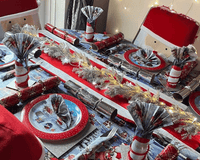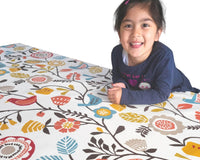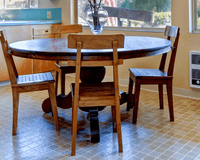Setting up a room goes beyond just selecting the ideal furniture or the right wall colour; it's also in the nuances. One often overlooked but crucial nuance is the tablecloth. A perfectly fitting tablecloth not only adds sophistication to your mealtime but also shields your table from potential spills and damage. But how can you guarantee that your oilcloth tablecloth, vinyl tablecloth, or PVC tablecloth aligns seamlessly with your table? This guide walks you through the steps to ensure impeccable measurements.
The Significance of Correct Tablecloth Measurements
Before delving into the specifics, let's understand the reasons for correct measurements:
-
Aesthetics: An overly large tablecloth can sag at the edges, while a short one might look inadequate.
-
Functionality: The primary role of a tablecloth is to shield your table. A cloth that doesn’t provide ample coverage can leave parts of the table vulnerable to spills or heat.
-
Safety Concerns: Overhanging tablecloths can pose tripping dangers, particularly in residences with toddlers or pets.
With the reasons clear, let's dive into the methodology.
Step 1: Identify Your Table's Shape
Firstly, recognise your table's geometry. Here are the four typical table shapes:
-
Round: A table that's all curves. It demands only one dimension - its diameter. Visualize those splendid round PVC tablecloths elegantly draping such tables.
-
Square: Four equal sides and a straightforward design.
-
Rectangle: Extended on one axis more than the other, maintaining angular corners.
-
Oval: Imagine stretched circles or elongated rounds. This shape might be best suited for a unique oval oilcloth tablecloth.
Each form necessitates a distinct approach to measurement. But fret not, armed with a reliable tape measure, you'll master it in no time!
Step 2: Measuring the Table's Dimensions
For this stage, a measuring tape is your ally. If you’re unfamiliar with its proper use, this guide might be of assistance:
-
Round Tables: Measure across the centre from one side to the opposite side to get the diameter. Easy!
-
Square and Rectangular Tables: Two dimensions are essential here. Measure the length (from one end to the other, longitudinally) and the breadth (sideways). Note, rectangles will display a longer length than breadth.
-
Oval Tables: A bit more challenging, you need to measure the longest length and the widest breadth across the table.
Step 3: Determining the Desired Drop or Overhang
Here's where personalisation comes into play! The "drop" refers to the extent the tablecloth suspends over the table's edges. A common range is between 10-30 centimetres, influenced by the event and your individual preference.
For instance, visualise a matt oilcloth tablecloth with a 20cm drop, presenting a blend of casual elegance.
Drop Calculation:
-
For a Round Table with a diameter of 89cm and a desired 15cm drop, you'll add 30cm (15cm on each side). This implies you'd need a 119cm diameter tablecloth.
-
A Square Table of dimensions 84x84cm, desiring a 18cm drop, demands an addition of 36cm to both sides, resulting in a 120x120cm tablecloth.
-
For Rectangle and Oval Tables, the method is consistent. Add twice the desired drop to both the length and breadth dimensions.
Remember, while the drop is largely subjective, some prefer a longer drop for big events or to hide an old table and a shorter one for regular family meals, you should also bear in mind if you have a very wide table you may have to sacrifice the amount of drop as the majority of PVC tablecloths are either 140cm wide or 132cm wide, however Table Protector Direct do stock a range of extra wide vinyl tablecloths between 155cm to 180cm in a limited range of designs.
The Next Layer of Precision: Table Extensions, Leaves, and Special Cases
Table extensions and leaves can add a degree of complexity when determining the ideal tablecloth size. However, it's imperative to get this right; after all, a table's look changes considerably when it's expanded, and it's paramount that its covering remains an impeccable fit. Let's delve deeper.
Step 4: Factor in Table Extensions and Leaves
Understanding Table Extensions and Leaves
Many dining tables come with extensions or leaves, allowing you to adjust the table size based on the occasion or number of guests. These can be central extensions that pop out from the table's centre or side leaves that can be attached or detached.
Measurement Approach:
-
Consistent Use: If you often use your table in its extended form (for instance, if you regularly host large family dinners), measure the table when extended. A clear PVC vinyl tablecloth would be apt, ensuring the table’s beauty remains visible.
-
Variable Use: If your table’s size varies frequently, consider two separate tablecloths - one for the regular size and another for the extended form. This strategy ensures a neat fit, regardless of how the table is set up.
-
Single Tablecloth Strategy: If you prefer a single tablecloth for all occasions, measure the table at its largest possible size. Opt for a tablecloth that offers an even drop, but not more than 15 centimetres over the edge when the table is at its smallest. Though the tablecloth might appear uneven on a smaller table, it's a convenient and cost-effective solution.
Step 5: When in Doubt, Reach Out!
Even with guidelines, there's no shame in seeking assistance to ensure perfection. If you're unsure about your measurements or the resulting tablecloth size, Table Protector Direct is at your service. With your table dimensions and desired drop in hand, they can guide you to the perfect tablecloth fit, be it an oilcloth, vinyl, or PVC, send us a message or use our live chat.











